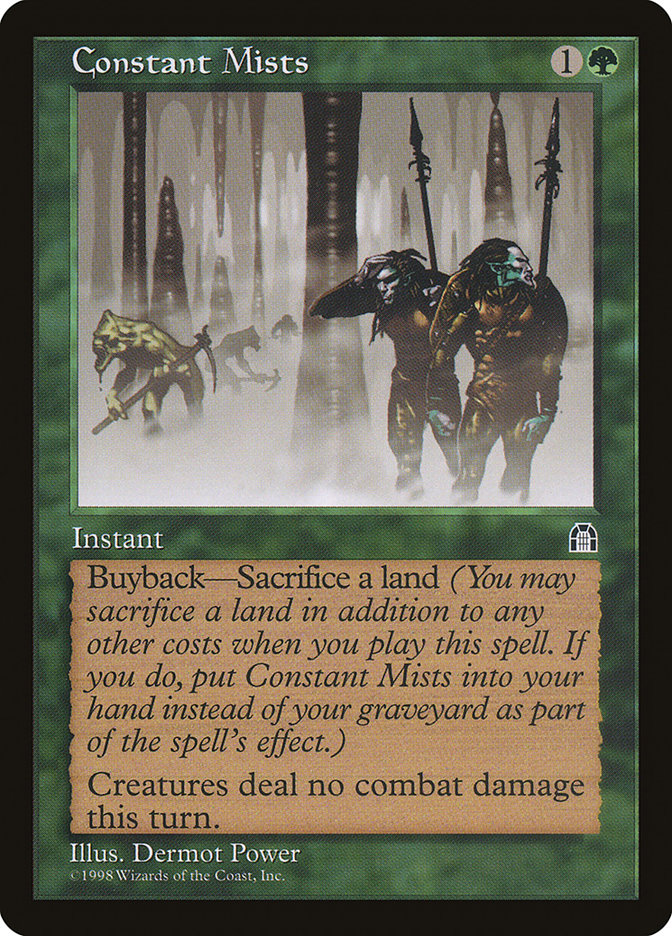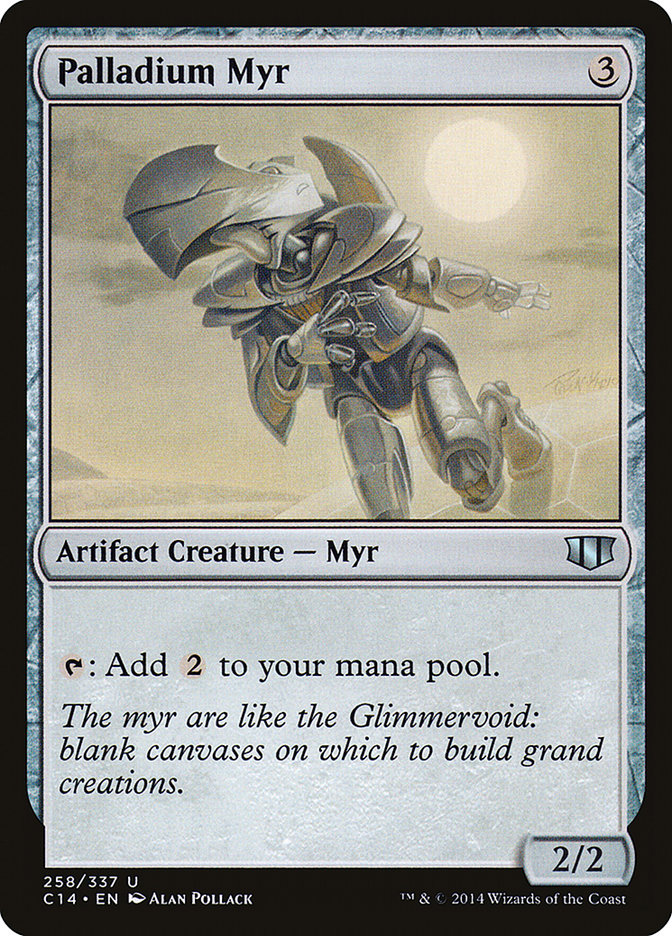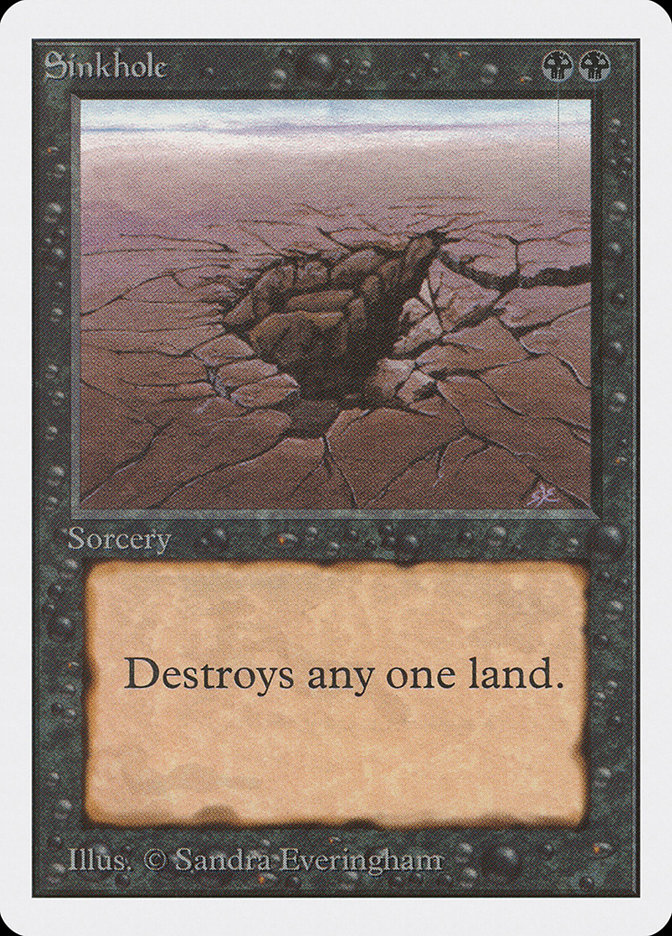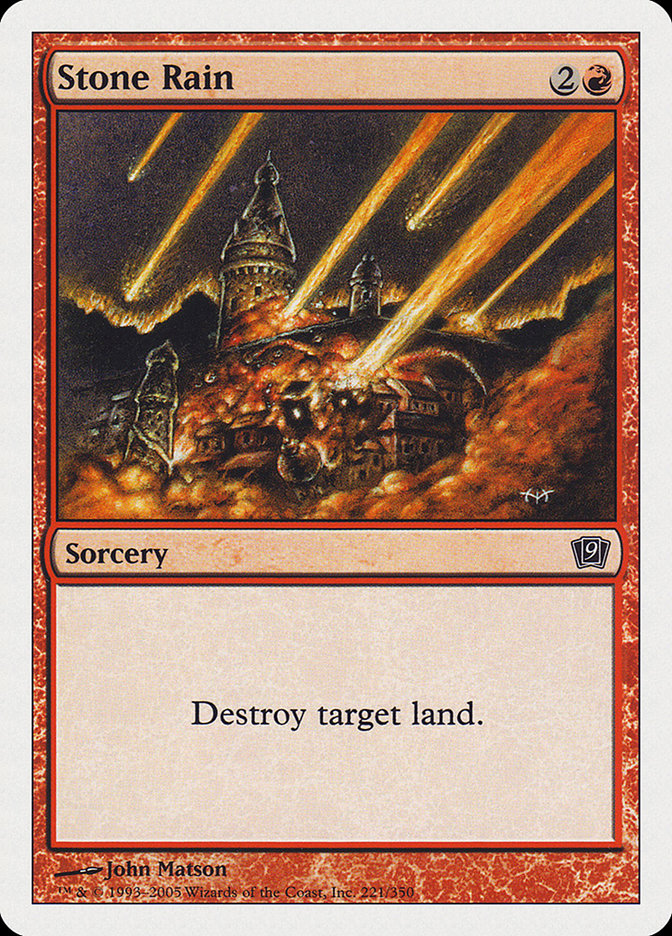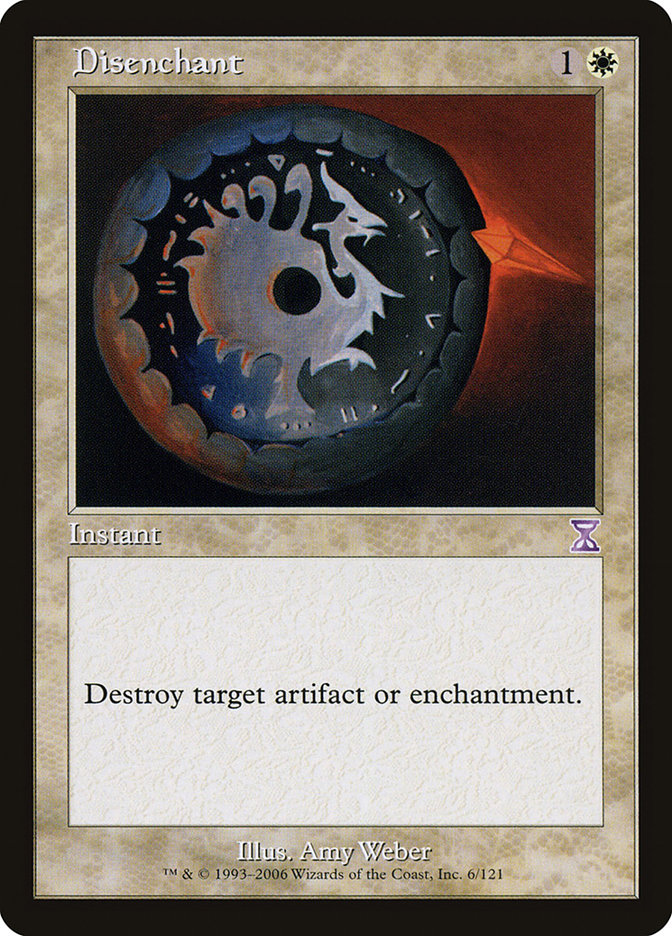 Boomerang for Unsummon and Chain Lightning for Lightning Bolt), we’ve had many spins on staple cards printed. Ice Age really pushed this as a draftable expansion that had a massive amount of redundancy built in.
Boomerang for Unsummon and Chain Lightning for Lightning Bolt), we’ve had many spins on staple cards printed. Ice Age really pushed this as a draftable expansion that had a massive amount of redundancy built in.
Knowing all the variants that are in print is beyond the ken of any normal person, but the vast number of cards printed can really broaden your options for card selection.
In fact, we have so many cards in print these days that finding the perfect card for your deck is extremely doable. I call this the Fog Effect.
Fog was printed a long time ago for stopping combat damage. It was a great trick. And as others have pointed out, such as Sheldon Menery, Fogs increase in power as the number and power of creatures scales up. When someone has a one-turn trick to kill you with Commander damage or spring out of nowhere, it’s nice to have a way to say, “No.”
Now, there’s nothing wrong with Fog. It suffices. It’s won’t disappoint.
But there are other Fog variants out there. Ideally, your Fog would prevent damage opposing creatures deal to you or your things, while your own are free to ambush and smash away the attackers that would dare to come your way. (See: Encircling Fissure or Harmless Assault.) If you have a lot of trampling creatures, then perhaps you would prefer Tanglesap. Do you have a fun Simic Commander deck with a +1/+1 counter theme? Check out Hindervines. If you are using your graveyard a lot, how about Moment’s Peace to flash it back? A blink deck would likely want Haze Frog.
And that’s not all. Constant Mists can be bought back and reused many times. If you run something like Crucible of Worlds, it’s even more valuable. In decks that churn out numerous lands, Constant Mists is very useful. Or you can lean on spells that really disrupt an opponent or blocker by keeping things tapped down for a while, like Tangle and Spore Cloud. Some decks want Spike Weaver and others want a flexible spell like Dawn Charm.
That’s not all, either. A token-based deck wants the populate of Druid’s Deliverance or maybe that of Arachnogenesis. If your metagame faces a lot of token decks themselves, maybe Blunt the Assault and its massive lifegain potential would be your Fog of choice. A monogreen deck can benefit more from Hunter’s Ambush.
Do you want to cross the streams? You could run an instant effect that prevents damage to your stuff as a way to keep them alive through combat or through something like removal. Take Akroma’s Blessing.
In many circumstances, it’s a virtual Fog since you just block and prevent the color of damage that your opponent’s creatures have. Plus, it can be used to stave off a Magmaquake or Pestilence or something similar. And you can use it to alpha strike past a mono-color defense as well (or to cycle it).
And there are variants of these effects here and there as well. Sivvi’s Ruse will prevent damage to your creatures, but not just combat damage. Channel Harm really shuts down a lot, but it’s a bit mana-intensive, so you might broadcast it a bit. Still, some decks could really benefit from that shutdown of damage twinned with creature removal. (See also: Comeuppance.) Prismatic Strands prevents damage from a source of burn and creatures that have that color. Instead of the buyback options of Prismatic Strants, what about the free option of Reverent Mantra? Both make sense.
And after you consider those, cards like Wrap in Vigor or Make a Stand or even Hold the Line are all in the conversation. All will keep your stuff alive through an attack while keeping you available to smash the folks who have dared to look askance at you.
And you know what? That’s just Fogs, damage prevention, and other similar effects! Those all go into different shells and fit in different needs. And if that’s how flexible and versatile a simple Fog can be, then you can see just how synergetic Magic has become.
Here, let’s look at a quick example. Sure, this article is intended for a Commander and Casual audience, but a quick little deck should work to highlight what I mean:
Creatures (14)
- 4 Hypnotic Specter
- 2 Avatar of Woe
- 2 Royal Assassin
- 2 Sphinx of Magosi
- 2 Sphinx of Uthuun
- 2 Sphinx of the Final Word
Lands (26)
Spells (20)

So let’s take a look at this quick shell that I tossed together. Do all of the elements work together? Is it worth changing some of the cards around?
I’m sure you’d agree that we could easily find better cards for Cancel or Terror. Perhaps Hypnotic Specter isn’t supported enough, so we could drop to a different ability like Vampire Nighthawk that’s better as an early drop in the early game due to its ability to keep things from attacking or to suck up some life for you. This deck has places to improve itself. And yet, it works. It’s adequate. Cancel does what you need it to do; still, that’s no reason not to run Dissipate or Hinder instead.
The perfect card is often out there.
I can’t tell you the number of times I’ve seen a mono-black deck run Diabolic Edict rather than Geth’s Verdict. When the BB cost of the Verdict isn’t any harder than the 1B one of the Edict, why not run the better one? I get why you might run the instant aspect of the Diabolic Edict over others. I personally like Chainer’s Edict the most due to its buyback ability. (I also get good value from Consuming Vapors.) But there are decks and occasions when an instant sacrifice effect is very valuable. So I get the argument. And I even get why Diabolic Edict is rocked over Geth’s Verdict in a two- or three-color deck. It’s easier to cast. But monoblack? Come on now!
You can do better than that.
You can do better than Fog. You can do better than Diabolic Edict or Terror or Cancel.
I’d run Murder over Terror in most builds unless Terminate works or we have mana-sensitive concerns with the double black, and then I’d embrace Rend Flesh instead. Terror is rarely the best choice, and the same remains true of Modern cards like Go for the Throat.
Let’s delve more into the Murder question. Many folks out there know that there are a few variants on Terror that I like to run in certain circumstances.
Expunge – Great for when you hold removal and there aren’t a lot of options. Just cycle it and move on.
Annihilate – In decks that don’t have a lot of cards that are drawing me stuff, a one-for-one trade that becomes a cantrip is suddenly a good card. It’s pure card advantage.
Eyeblight’s Ending – Usually second fiddle to Rend Flesh because I find that Elves are played more than Spirits, but that’s not always the case at every metagame, and in Commander, you often need duplication.
Hero’s Resolve – Yay for killing planeswalkers. It was a bit pricey, but post-rotation it’s dropped to reasonable levels for most Casual aficionados.
Don’t forget to exile stuff with Unmake, add in non-creature removal with Vindicate or Mortify, and to layer in mono-black exiling with Gild, Silence the Believers, and so forth. Silence the Believers is great for when you expect to have more mana, like with decks that have Cabal Coffers or ramp. Meanwhile, Sever the Bloodline is useful since it kills a lot of stuff with the same name, such as creature tokens. (And it has Flashback to boot.) You can run the best stuff to fit your colors, deck, and needs.
And this continues to be true of many things, not just utility spells.
What about mana-making creatures?
Do you have a two-color deck that includes green? Do you want to have a creature that taps for both green and your other color? What two-drops are there to help you? Well, sure, you could run Sylvan Caryatid or Utopia Tree. But Skyshroud Elf is better for G/R or G/W since you can churn lots of mana to make your color. And if you are running all three, then it’s downright ideal in that Naya shell.
What about Quirion Elves? They work in any two-color deck to smooth mana, no matter what, and they grab equipment and can swing for damage. So unless you really want the Caryatid to block early drops or to play well with defender mechanics (like Vent Sentinel or Wall of Mulch), then it’s not always the best choice for a two-drop to smooth mana in a two-color deck. There’s always something else that’s better.
Don’t sleep on Gold Myr or Sea Scryer. Urborg Elf and Quirion Explorer exist. Run Palladium Myr in your decks.
And again, that was just the tip of the iceberg of mana producing creatures. There are shells that want Scuttlemutt or Elves of Deep Shadow or Priest of Titania.
And this continues to hold true for other mana things like mana-producing artifacts (mana rocks). A control deck with few creatures and some sweeping effects may want to lean on artifacts or lands that become creatures like Azorius Keyrune, Guardian Idol, and even Mishra’s Factory. Meanwhile, a deck that is going late and needs to draw some cards (particularly in colors that don’t draw a lot of cards) is going to find value with things that you can turn into cards later on like Mind Stone, Hedron Archive, and Boros Cluestone.
Your deck shouldn’t just have 26 Islands. It doesn’t need to run the basic Tidings, either. You can run something that better suits what you are looking for.
I’m going to give you one more example before leaving you.
Lots of players lean on the same old spells, creatures and effects for artifact and enchantment removal. Acidic Slime. Vandalblast. Into the Core. Orim’s Thunder. Wear // Tear. Vindicate. Utter End. Angel of Vengeance. Stuff like that.
So let’s look into the issues a bit more.
People don’t run enchantments as much as they used to. You used to see a card like Wild Growth get played a lot more. Compare it to Llanowar Elves. It can’t swing. It can’t block. It’s vulnerable to enchantment removal. You can only use it when you tap the land it’s on. Why would you even want it? Other than an enchantment-heavy deck that seeks to harness the power of triggers like Sigil of the Empty Throne or Mesa Enchantress, it’s hard to see how it’s used.
Right?
Well, it used to be used more often. A control deck that’s dropping Wrath of God won’t kill their one-drop mana accelerant. People are more likely to run Terror or Lightning Bolt, Fireball or Swords to Plowshares against your Llanowar Elves than Disenchant against your Wild Growth. The one thing you truly feared, land destruction isn’t played much anymore. It’s not like Ice Storm, Sinkhole, or Stone Rain are dominating today’s Casual tables.
But that lingering fear against enchantments is still there, so usually when you see an enchantment out on the board, it’s a major threat. Artifacts are all over. You have equipment, mana rocks, artifact creatures of all stripes, and then everything from utility stuff to broken mechanics. You are just as likely to see utility artifacts like Nihil Spellbomb as you are Mind’s Eye.
Understanding that artifacts are a lot more common, but enchantments are more powerful when played, is a key to figuring out how to attack them. How are they vulnerable? And does your playgroup follow this norm? And can you exploit it?
Check yourself the next time you have a Disenchant effect in your hand of any sort. I like Dismantling Blow and Orim’s Thunder the best. Ask some honest questions of the battlefield. If you had to play it right now, how many enchantment targets are out there? How many are real threats to you? How many artifacts are there? And of those, how many are threats?
You know Magic well enough to read a table. Suppose a Loxodon Warhammer, which normally wouldn’t be a threat for removal, is on someone’s Commander Dakkon Blackblade, who can now kill in one or two attacks with Commander damage. The Warhammer suddenly has moved up. When you honestly ask yourself these questions, I think you’ll see that artifacts are more commonly seen and less likely to be serious targets than enchantments.
So having both effects is helpful, just in case. There’s value in a card like Shattering Pulse or Into the Core, no doubt. But you often need to keep your options open.
I prefer a card like Return to Dust. You can use it to off two things if you cast it on your turn and collect that card advantage doing so, or you can use it to handle a problem instantly if that’s needed. And the exiling effect is a nice bonus to boot. But again, not every deck wants it.
Decks with a lot of lifegain triggers may look for something else. A Brago, King Eternal blink deck should be looking for an answer that’s blinkable (Act of Authority comes to mind). A deck with a sabotage element that wants to sneak in and hit people would likely want a creature like Soltari Visionary or Trygon Predator.
Being able to handle enchantments and artifacts at the kitchen table is an important part of keeping yourself in the game, so finding the perfect adjunct for your deck’s theme is virtually important to success.
And that’s true with everything you play. Your lands. Your utility creatures. Your Walls. Your removal. Your countermagic. Your discard effects. Your burn. Your bounce. Your beaters. Your tricks. Your card drawing.
Shoot, when there are so many Fogs that I could spend an entire article talking about each one and where it fits best, then you know that there are enough Lightning Bolt variants or Rampant Growths out there in other places to delve into and explore. Finding and adding in the best ones will help to unlock your deck’s potential!


